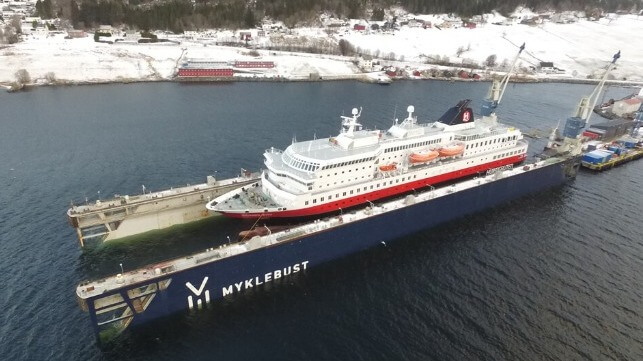Hurtigruten’s Coastal Fleet Begins Largest Environmental Upgrades

Work is getting underway on what is being called one of Europe's largest environmental upgrades as Hurtigruten Norway continues the upgrades for its coastal fleet to reduce their environmental impact and meet future regulations. When the project is completed in 2023, Hurtigruten expects the rebuilt ships will cut CO2 emissions by 25 percent and NOx emissions by as much as 80 percent.
By the summer of 2023, Hurtigruten plans to have converted three of its coastal vessels to hybrid propulsion plants. In addition, these vessels as well as three others in the fleet will be outfitted with emissions technology. The six ships currently slated for upgrades are in addition to a seventh vessel, the Vesterålen, which was upgraded with new engines and emissions technologies in 2019. The vessels make up the company’s coastal fleet operating from Bergen to northern Norway and are separate from Hurtigruten Expeditions that operates the expedition cruise ships including vessels converted from the coastal fleet.
"This is the largest environmental upgrade in Hurtigruten's history, and one of the largest of its kind in Europe. This will make a real impact in reducing emissions in Norwegian waters. The fact that such an investment also leads to ripple effects in the local communities along the coast, is something we are very proud of," said Hedda Felin, CEO, Hurtigruten Norway.
The first of the vessels, the Richard With, which was built in 1993, is currently at Myklebust Yard in northwestern Norway, where the ship will be fitted with new main engines and large battery packs. The 11,200 gross ton vessel was previously upgraded in 2018 so that she could offer expedition cruises. She is due to return to service on August 9, 2022. Her sister ship, the Kong Harald, also built in 1993 and last refitted in 2016, is due to began her conversion also at the Myklebust Yard once the Richard With returns to service. The plan also calls for the awarding of a contract to convert the third ship of the class the Nordlys to undergo a similar conversion before the summer of 2023.
“This is one of the largest environmental vessel upgrades to be undertaken in Europe,” said Egil Haugsdal, President, Kongsberg Maritime. Kongsberg Maritime is responsible for design work and upgrades on the three ships that will undergo the hybrid conversion.
In addition to new engines and large battery packs, other elements of the work include the installation of new propeller blades, hull optimization, a new bulbous bow, new gears, generators, and new control systems. When completed, each of the vessels will have emissions equivalent to Tier III. The upgrades also include the installation of state-of-the-art wastewater treatment plants.
The other three ships operating on the coastal service, the Nordnorge, Nordkapp, and Polarlys, which are a few years younger and slightly larger vessels, will receive less extensive upgrades. All six of the ships, however, will be outfitted with selective catalytic reduction (SCR) equipment. The technology is considered to be one of the most efficient methods to reduce NOx emissions.
Hurtigruten noted that its goal was to take the entire fleet to zero emissions, but said that the technologies are not mature enough yet for their operations. However, Hurtigruten Norway will also use certified biofuels on a large scale to cut CO2 emissions and they noted that all the ships already have shore power convertibility, eliminating emissions in ports with shore power available.
